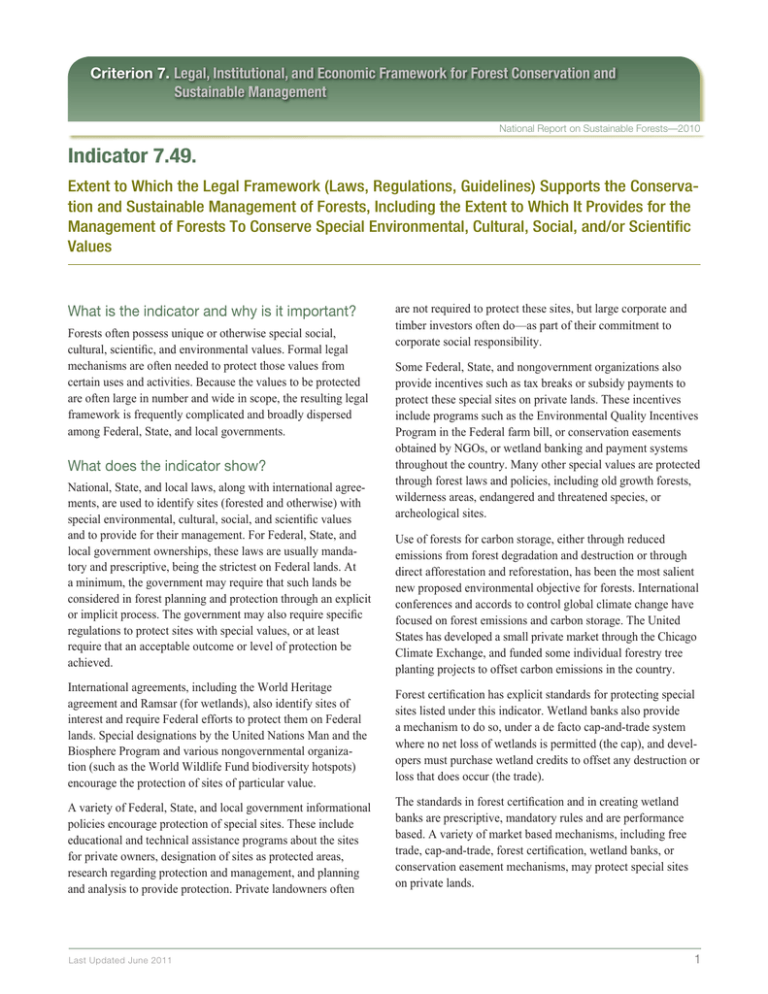Indicator 7.49.
advertisement

Criterion 7. Legal, Institutional, and Economic Framework for Forest Conservation and Sustainable Management National Report on Sustainable Forests—2010 Indicator 7.49. Extent to Which the Legal Framework (Laws, Regulations, Guidelines) Supports the Conservation and Sustainable Management of Forests, Including the Extent to Which It Provides for the Management of Forests To Conserve Special Environmental, Cultural, Social, and/or Scientific Values What is the indicator and why is it important? Forests often possess unique or otherwise special social, cultural, scientific, and environmental values. Formal legal mechanisms are often needed to protect those values from certain uses and activities. Because the values to be protected are often large in number and wide in scope, the resulting legal framework is frequently complicated and broadly dispersed among Federal, State, and local governments. What does the indicator show? National, State, and local laws, along with international agreements, are used to identify sites (forested and otherwise) with special environmental, cultural, social, and scientific values and to provide for their management. For Federal, State, and local government ownerships, these laws are usually mandatory and prescriptive, being the strictest on Federal lands. At a minimum, the government may require that such lands be considered in forest planning and protection through an explicit or implicit process. The government may also require specific regulations to protect sites with special values, or at least require that an acceptable outcome or level of protection be achieved. are not required to protect these sites, but large corporate and timber investors often do––as part of their commitment to corporate social responsibility. Some Federal, State, and nongovernment organizations also provide incentives such as tax breaks or subsidy payments to protect these special sites on private lands. These incentives include programs such as the Environmental Quality Incentives Program in the Federal farm bill, or conservation easements obtained by NGOs, or wetland banking and payment systems throughout the country. Many other special values are protected through forest laws and policies, including old growth forests, wilderness areas, endangered and threatened species, or archeological sites. Use of forests for carbon storage, either through reduced emissions from forest degradation and destruction or through direct afforestation and reforestation, has been the most salient new proposed environmental objective for forests. International conferences and accords to control global climate change have focused on forest emissions and carbon storage. The United States has developed a small private market through the Chicago Climate Exchange, and funded some individual forestry tree planting projects to offset carbon emissions in the country. International agreements, including the World Heritage agreement and Ramsar (for wetlands), also identify sites of interest and require Federal efforts to protect them on Federal lands. Special designations by the United Nations Man and the Biosphere Program and various nongovernmental organization (such as the World Wildlife Fund biodiversity hotspots) encourage the protection of sites of particular value. Forest certification has explicit standards for protecting special sites listed under this indicator. Wetland banks also provide a mechanism to do so, under a de facto cap-and-trade system where no net loss of wetlands is permitted (the cap), and developers must purchase wetland credits to offset any destruction or loss that does occur (the trade). A variety of Federal, State, and local government informational policies encourage protection of special sites. These include educational and technical assistance programs about the sites for private owners, designation of sites as protected areas, research regarding protection and management, and planning and analysis to provide protection. Private landowners often The standards in forest certification and in creating wetland banks are prescriptive, mandatory rules and are performance based. A variety of market based mechanisms, including free trade, cap-and-trade, forest certification, wetland banks, or conservation easement mechanisms, may protect special sites on private lands. Last Updated June 2011 1 National Report on Sustainable Forests—2010 Table 49-1. Policy and Governance Classification. Mechanism Nondiscretionary/mandatorya Informational/educationalb Discretionary/voluntaryc Fiscal/economicd Market basede Scale: National (N), Regional (R), State (S), Local (L) N, S, L N, S, L N, S, L N, S, L R, N, S, L Approach Prescriptive L, R, I, G C, W Process or Systems Based Performance or Outcome Based Private Enterprise L, R, I, G E, T, P, R, A L, R, G R I, T, P C, W S I, T, P W, T, M, C, E Laws (L), Regulations or Rules (R), International Agreements (I), Government Ownership or Production (G). b Education (E), Technical Assistance (T), Research (R), Protection (P), Analysis and Planning (A). c Best Management Practices (B), Self-regulation (S). d Incentives (I), Subsidies (S), Taxes (T), Payments for Environmental Service (P). e Free enterprise, private market allocation of forest resources (M), or market based instruments and payments, including forest certification (C) wetland banks (W), capand-trade (T), conservation easement or transfer of development rights (E). a What has changed since 2003? Various changes have occurred to encourage habitat conservation of threatened and endangered species; to set aside Federal lands to protect archaeological resources, wilderness areas, scenic rivers, national trails, and wildlife refuges; to protect wetlands; and to govern surface mining and reclamation. These conservation efforts include the explicit designation of individual wilderness, scenic rivers, national trail system, or archeological areas. Last Updated June 2011 Increased Federal conservation support also includes a large amount of Federal funding through agency budgets and grants to private forest landowners, particularly through the 2002 and 2008 Farm Bills. The Farm Bills also have substantially increased incentives for programs that provide environmental services. The IRS Code also allows for tax deductions with qualified conservation easements or with land donations to land trusts. 2



